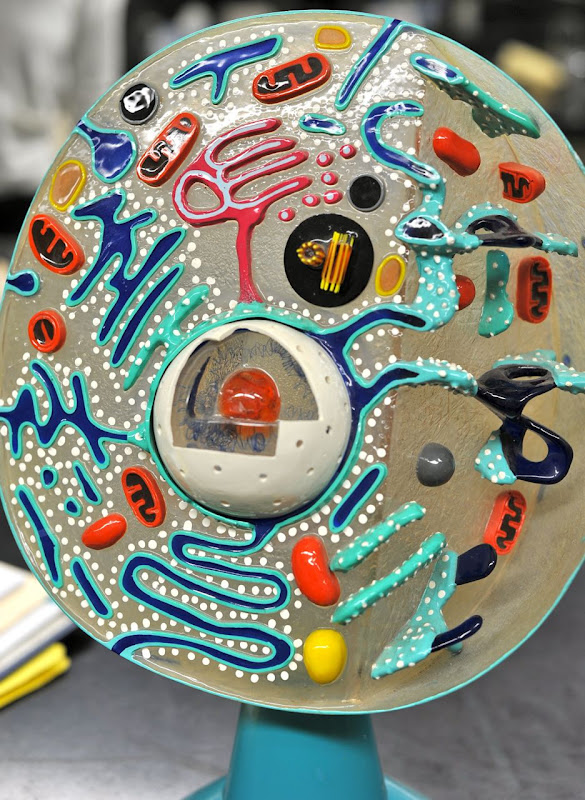Quiz Answers for the 8 A.M. Lab. (Average score = 6.44)
Quiz Answers for the 10 A.M. Lab. (Average score = 7.37)
- The heart is ventral/anterior to the spine.
- What is the name and the role of the marked organelle? Golgi apparatus; a sorting station: it packages, modifies, and segregates proteins for various destinations in and outside of the cell
- What is the name of this epithelial tissue? Where can you find it? simple cuboidal epithelium; kidney tubules (also: ovary surface, ducts of small glands)
- What is the name of the cavity in which the lung is located? pleural cavity
- What is the name and the role of the marked organelle? nucleolus; ribosome production and assembly
- What is the name of this epithelial tissue? Where can you find it? stratified squamous epithelium, nonkeratinized; esophagus (also: mouth, vagina)
- What is a chondrocyte? a cell type found in cartilage responsible for the production and maintenance of the cartilaginous matrix
- What is the name of this epithelial tissue? Where can you find it? simple columnar epithelium, nonciliated, with microvilla; stomach mucosa (also: the digestive tract, gallbladder)
- What is the name of the anatomical plane that divides the body into ventral and dorsal sections? frontal/coronal plane
- What is a keratinocyte? a dominant cell type present in the epidermis
Quiz Answers for the 10 A.M. Lab. (Average score = 7.37)
- The liver is ventral/anterior to the spine.
- What is the name and the role of the marked organelle? rough endoplasmic reticulum; proteins are synthesized on ribosomes and further modified and packaged into vesicles in rough ER
- What is the name of this epithelial tissue? Where can you find it? simple columnar epithelium, nonciliated, with microvilla; stomach mucosa (also: the digestive tract, gallbladder)
- What is the name of the membrane that lines your nose? mucous membrane
- What is the name and the role of the marked organelle? Golgi apparatus; a sorting station: it packages, modifies, and segregates proteins for various destinations in and outside of the cell
- What is the name of this epithelial tissue? Where can you find it? simple cuboidal epithelium; kidney tubules (also: ovary surface, ducts of small glands)
- What is a chondrocyte? a cell type found in cartilage responsible for the production and maintenance of the cartilaginous matrix
- What is the name of this epithelial tissue? Where can you find it? stratified squamous epithelium, nonkeratinized; esophagus (also: mouth, vagina)
- What is the name of the anatomical plane that divides the body into right and left sections? sagittal/median/midsagittal plane
- What is a keratinocyte? a predominant cell type present in the epidermis
Quiz Answers for the 2 P.M. Lab. (Average score = 6.65)
- My wrist is proximal to my fingers.
- The spleen is in the left upper abdominal quadrant.
- What is the name and the role of the marked organelle? smooth ER; lipid synthesis
- What is the name of this epithelial tissue? Where can you find it? simple cuboidal epithelium; kidney tubules (also: ovary surface, ducts of small glands)
- What is the name and the role of the marked organelle? mitochondrion; ATP/energy production
- What is this dark pink structure? nucleus
- What is the name of this epithelial tissue? Where can you find it? stratified squamous epithelium, nonkeratinized; esophagus (also: mouth, vagina)
- What is the name of this epithelial tissue? What does the arrow point to? pseudostratified columnar epithelium; cilia
- The cartilage cell is called the chondrocyte.
- Define the term: Axon An axon is a long, slender projection of a nerve cell (neuron) that typically conducts electrical impulses away from the neuron's cell body or soma.
Quiz Answers for the 4 P.M. Lab. (Average score = 6.29)
- My fingers are distal to my wrist.
- The liver is in the right upper abdominal quadrant.
- What is the name and the role of the marked organelle? Golgi apparatus; a sorting station: it packages, modifies, and segregates proteins for various destinations in and outside of the cell
- What is the name of this epithelial tissue? Where can you find it? simple cuboidal epithelium; kidney tubules (also: ovary surface, ducts of small glands)
- What is the name and the role of the marked organelle? nucleolus; ribosome production and assembly
- What is this dark pink structure? nucleus
- What is the name of this epithelial tissue? Where can you find it? stratified squamous epithelium, nonkeratinized; esophagus (also: mouth, vagina)
- What is the name of this epithelial tissue? Where can you find it? pseudostratified columnar epithelium; trachea
- The cartilage cell is called the chondrocyte.
- Define the term: Axon An axon is a long, slender projection of a nerve cell (neuron) that typically conducts electrical impulses away from the neuron's cell body or soma.









